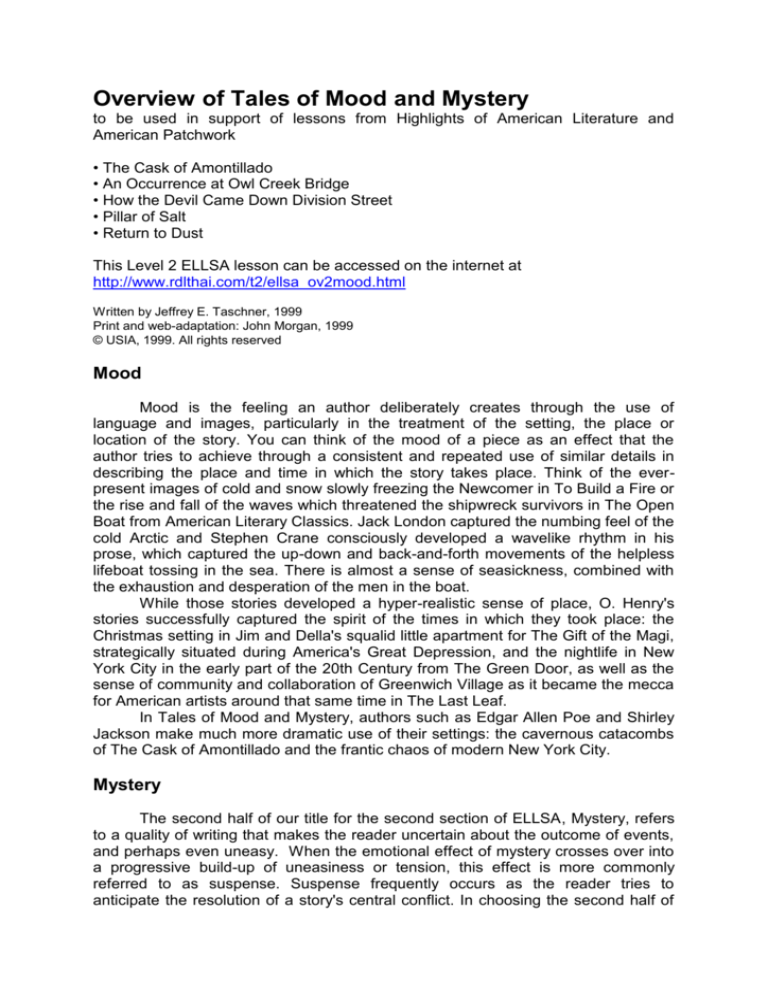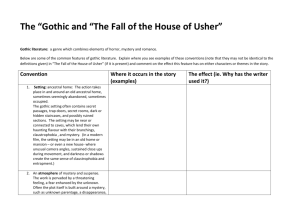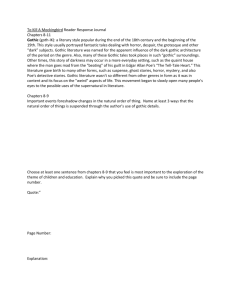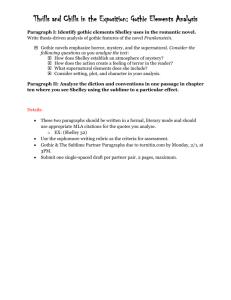
Overview of Tales of Mood and Mystery
to be used in support of lessons from Highlights of American Literature and
American Patchwork
• The Cask of Amontillado
• An Occurrence at Owl Creek Bridge
• How the Devil Came Down Division Street
• Pillar of Salt
• Return to Dust
This Level 2 ELLSA lesson can be accessed on the internet at
http://www.rdlthai.com/t2/ellsa_ov2mood.html
Written by Jeffrey E. Taschner, 1999
Print and web-adaptation: John Morgan, 1999
© USIA, 1999. All rights reserved
Mood
Mood is the feeling an author deliberately creates through the use of
language and images, particularly in the treatment of the setting, the place or
location of the story. You can think of the mood of a piece as an effect that the
author tries to achieve through a consistent and repeated use of similar details in
describing the place and time in which the story takes place. Think of the everpresent images of cold and snow slowly freezing the Newcomer in To Build a Fire or
the rise and fall of the waves which threatened the shipwreck survivors in The Open
Boat from American Literary Classics. Jack London captured the numbing feel of the
cold Arctic and Stephen Crane consciously developed a wavelike rhythm in his
prose, which captured the up-down and back-and-forth movements of the helpless
lifeboat tossing in the sea. There is almost a sense of seasickness, combined with
the exhaustion and desperation of the men in the boat.
While those stories developed a hyper-realistic sense of place, O. Henry's
stories successfully captured the spirit of the times in which they took place: the
Christmas setting in Jim and Della's squalid little apartment for The Gift of the Magi,
strategically situated during America's Great Depression, and the nightlife in New
York City in the early part of the 20th Century from The Green Door, as well as the
sense of community and collaboration of Greenwich Village as it became the mecca
for American artists around that same time in The Last Leaf.
In Tales of Mood and Mystery, authors such as Edgar Allen Poe and Shirley
Jackson make much more dramatic use of their settings: the cavernous catacombs
of The Cask of Amontillado and the frantic chaos of modern New York City.
Mystery
The second half of our title for the second section of ELLSA, Mystery, refers
to a quality of writing that makes the reader uncertain about the outcome of events,
and perhaps even uneasy. When the emotional effect of mystery crosses over into
a progressive build-up of uneasiness or tension, this effect is more commonly
referred to as suspense. Suspense frequently occurs as the reader tries to
anticipate the resolution of a story's central conflict. In choosing the second half of
our title, we wanted to be somewhat poetic, but more importantly, we are paying
special tribute to the American master of Mood and Mystery, Edgar Allen Poe,
whose story, The Cask of Amontillado, and other masterpieces appeared in his
classic anthology Tales of Mystery and Imagination.
Genre
In Tales of Mood and Mystery, we move beyond the basic elements of fiction
writing and examine more subtle techniques of the writer's craft and particular style.
All the pieces chosen are in their original version, as the author intended them. The
language has not been simplified, adapted or altered in any manner. In addition to
its more authentic and complex language and a deeper exploration of technique and
style, and reader orientation.
Tales of Mood and Mystery goes beyond American Literary Classics in its
attempt to develop of framework for classifiying these works by genre. We define
genre as a distinct literary form, characterized by a particular language, style and
tradition.
The pieces in Tales of Mood and Mystery represent specific genres, (and
sub-genres) of literature and we shall attempt to classify each piece, as well as
define the genre to which it belongs.
Selections from Highlights of American Literature
•
•
•
Edgar Allan Poe, The Cask of Amontillado
(genre: gothic)
Ambrose Bierce, The Occurrence at Owl Creek Bridge
(genre: horror)
George Bamber, Return to Dust
(genre: science fiction)
Selections from American Patchwork
•
•
Shirley Jackson, Pillar of Salt
(genre: terror)
Nelson Algren, How The Devil Came Down Division Street
(genre: ghost story)
Definitions
Gothic Literature
Gothic literature is characterized by gloomy settings such as castles and old,
dark houses, in which mysterious and sometimes violent or supernatural
occurrences take place. Originally, the term Gothic was confined to a specific genre
of mostly 18th and 19th Century British literature. Mary Wollstonecraft Shelley's,
Frankenstein and Bram Stoker's Dracula are perhaps the most famous examples of
this tradition, although the works of Ann Radcliffe and Emily Bronte figure
prominently as well. We might consider this tradition to be Gothic with a capital G.
Many of the stories of Edgar Allen Poe contain gothic elements, such as the
crumbling manor in The Fall of the House of Usher or the gloomy catacombs in The
Cask of Amontillado. Critics, therefore, often include such works as these, as well as
some of the works of other prominent American authors such as Henry James and
Ambrose Bierce.
Frederick Frank, Professor of English at Allegheny University, believes that
the tradition of gothic literature, as practiced in America, "rapidly diverged from the
European model just as our country had broken away from England". Frank states
that the American gothic reflects a "unity of mood and theme". He traces the
emergence of a distinct tradition of American gothic from the work of the lateEighteenth Century author, Charles Brockden Brown, to more contemporary authors
such as H.P. Lovecraft, Shirley Jackson, Joyce Carol Oates, all the way to Stephen
King. He even argues that Moby Dick by Herman Melville, considered by many
critics to be the greatest American novel ever written, is an example of American
gothic.
David Punter, British author and lecturer in the School of English and
American Studies at the University of East Anglia, likewise treats both British and
American gothic traditions separately, but attempts to bridge them through common
themes of social alienation and psychological fear and repression. He represents
one of a growing number of academics and serious literary critics who refuse to
dismiss this body of literature as mere escapism. Although, he recognizes distinct
American and British traditions, Punter is also one of the leaders of a growing trend
of analysts who choose to group much of the literature of horror and mystery on
both sides of the Atlantic under the single genre heading of Gothic Literature.
References
Punter, D. (1980) The Literature of Terror: A History of Gothic Fictions from 1765 to
the Present Day. Longman: Hong Kong.
Frank, F. S. (1990) Through the Pale Door: A Guide to and through the American
Gothic. Frank, Greenwood Press: Westport, Conn.
On-line resource
An outstanding site featuring links to e-text versions of gothic stories and novels can
be found at Jack G. Voller's The Literary Gothic.
http://www.siue.edu/~jvoller/gothic.html
Horror and the top 40 horror books of all time
Horror is a genre of literature which is often characterized by supernatural
creatures and fantastic occurrences, as well as by violence and death.
Here are the top 40 horror books of all time, as chosen by the Horror Writers
Association, http://www.horror.org (featuring the Stoker Awards annual competition
for best horror writing).
Note: This list is alphabetical by surname; no ranking is implied. (Note the
predominance of American authors here, not to mention the inclusion of Thai
author, S.P. Somtow.)
1.
Best Ghost Stories of Algernon Blackwood
2.
3.
4.
5.
6.
7.
8.
9.
10.
11.
12.
13.
14.
15.
16.
17.
18.
19.
20.
21.
22.
23.
24.
25.
26.
27.
28.
29.
30.
31.
32.
33.
34.
35.
36.
37.
38.
39.
40.
The Exorcist by William Peter Blatty
Something Wicked This Way Comes by Ray Bradbury
Lost Souls by Poppy Z. Brite
The Hungry Moon by Ramsey Campbell
The Between by Tananarive Due
Darklands by Dennis Etchison
Raven by Charles L. Grant
Dead in the Water by Nancy Holder
The Haunting of Hill House by Shirley Jackson
The Lottery and Other Stories by Shirley Jackson
Turn of the Screw by Henry James
The Ghost Stories of M.R. James
Dr. Adder by K.W. Jeter
The Metamorphosis and Other Stories by Franz Kafka
Pet Semetary by Stephen King
The Shining by Stephen King
The Stand by Stephen King
Skin by Kathe Koja
Dark Dance by Tanith Lee
Conjure Wife by Fritz Leiber
Rosemary's Baby by Ira Levin
Songs of a Dead Dreamer by Thomas Ligotti
Lovers Living, Lovers Dead by Richard Lortz
The Dunwich Horror and Others by H.P. Lovecraft
At the Mountains of Madness by H.P. Lovecraft
The Hill of Dreams by Arthur Machen
Tales of Horror and the Supernatural by Arthur Machen
Sineater by Elizabeth Massie
I Am Legend by Richard Matheson
Relic by Douglas Preston and Lincoln Childs
Frankenstein by Mary Shelley
Book of the Dead edited by John Skipp and Craig Spector
Ghoul by Michael Slade
Vampire Junction by S.P. Somtow
The Strange Case of Dr. Jekyll and Mr. Hyde by Robert Louis Stevenson
Dracula by Bram Stoker
Some of Your Blood by Theodore Sturgeon
Phantom by Thomas Tessier
Sacrifice by Andrew Vachs
Compiled by Thomas Deja and Nicholas Kauffman
Influences
Classifications
Fantasy
Characteristics: other worlds, other realities, modern medieval (sword & sorcery)
Sampling of authors and works:
• J.R.R. Tolkein (The Hobbit, The Lord of the Rings)
• Peake (Gormanghast)
• Ursula LeGuin (The Last Unicorn)
Science Fiction
Characteristics: futurism, technology, scientific speculation, aliens, space travel
Sampling of authors and works:
•
•
•
•
Arthur C. Clarke (2001)
Isaac Asimov (Foundation)
Ray Bradbury (Fahrenheit 451)
James Herbert (Dune)
Horror
Characteristics: death, violence, possibly war, creatures/monsters (vampires,
werewolves, zombies, gill-men, mummies, disfigurations).
Sampling of authors and works:
• Ambrose Bierce (...Owl Creek Bridge)
• Bram Stoker (Dracula)
• Poppy Z. Brite (Lost Souls)
Supernatural
Characteristics: witchcraft, demons, black magic, paranormal occurences (ESP,
telekinesis, etc.).
Sampling of authors and works:
• Nathaniel Hawthorne (Dr. Heidegger's Experiment)
• H.P. Lovecraft (The Cthulu Mythos)
• Blatty (The Exorcist)
Gothic
Characteristics: gloomy setting (castles, old houses, caves, catacombs,
monasteries, convents), stock characters (suspicious servants, sinful clergy, sickly
characters), mysterious events
Sampling of authors and works:
• Edgar Allan Poe (Amontillado, Usher)
• Radcliffe (Udolpho)
• Lewis (The Monk)
The Ghost Story
Characteristics: spirits of the dead, hauntings
Sampling of authors and works:
• Henry James (Turn of the Screw)
• William Shakespeare (Hamlet)
• Charles Dickens (Christmas Carol)
Terror
Characteristics: heightened suspense, psychological illness, stalking, pursuit,
paranoia, focus on fear rather than death, thrills.
Sampling of authors and works:
• DeMaupassant (The Horla)
• Shirley Jackson (Pillar of Salt)
Mystery
Characteristics: crime, detectives, criminal society, police investigation.
Sampling of authors and works:
• Edgar Allan Poe (The Gold Bug)
• Sir Arthur Conan Doyle (Sherlock Holmes stories)
• Agatha Christie (Ten Little Indians)
Magical Realism
Characteristics: miraculous or magical occurrences that happen in realistic,
everyday settings.
Sampling of authors and works:
• Gabriel Garcia Marquez (100 Years of Solitude)
• Cecile Pin้da (The Love Queen of the Amazon)
• Angela Carter (Nights at the Circus, Wise Children)
Surrealism
Characteristics: inexplicable happenings, coincidence, hallucinations, narrative
experimentation.
Sampling of authors and works:
• William. Burroughs (Naked Lunch)
• Jean Genet (Lady of the Flowers)
• Breton (Nadja)









